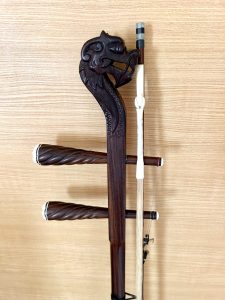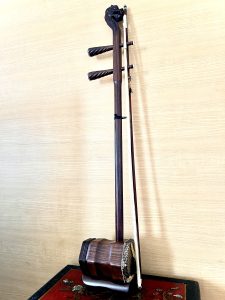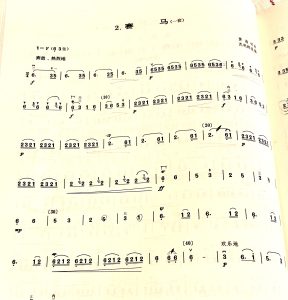人の声に一番近い楽器(愛知県名古屋市千種区 骨董買取 古美術風光舎)
2023.07.02
皆さまこんにちは。スッタフHでございます。
先日のブログで龍のお話をさせていただきましたが、我が家にも小さな龍がおりました。


中国やモンゴルの伝統楽器である二胡です。
以前中国に住んでいた時に少しだけ習っていました。
二胡の元になる楽器は宋の時代には既に存在していたとのこと。
弦が2本のみで、弦を押さえつける板がなく、弦が浮いている状態で演奏するという非常に弾くのが難しい楽器です。
しかしその音色は深く多彩で、人間の声に最も近いといわれています。
そのため伝統的な名曲から現代の様々なジャンルの曲まで不思議としっくり馴染みます。
日本でもブームとなった「女子十二楽坊」の華麗な演奏を思い起こす方もいるかと思います。
個人的には今年3月に亡くなられた坂本龍一さんの「戦場のメリークリスマス」は二胡で聞くとまた違う趣があって引き込まれます。
のちに作曲された映画のサウンドトラック音楽「ラストエンペラー」にも二胡の演奏が組み込まれていましたね。
素敵な音色だなと思っていましたが、実際に自分でも弾いてみたいと思ったきっかけがありました。
コンサートで聴いた「賽馬」という伝統的な曲で、モンゴルの草原を走る競争馬を表現しており、颯爽と走る馬の姿が目の前に浮かんできます。
ラストの馬のいななきは二胡でしか表現できない臨場感があり圧倒されます。
たくさん動画もあがっているので機会があればぜひ聴いてみてくださいね。
しかしこの「賽馬」。実は超高速、超絶技巧の曲とされており、なぜ自分が弾きたいと思ったのか不思議で、今となってはおこがましい限りです。
まず弓を横に引き、音をだすだけでも大変で、家で練習しているとギーギーとけたたましい音が鳴るので家族はさぞ迷惑だったことでしょう。
二胡の音符はオタマジャクシの音符ではなく、数字譜が使われています。
簡単にいうと、ドが1、レが2、ミが3…と続きます。
つまり童謡の「チューリップ」のさいた~さいた~はドレミ~ドレミ~なので、123 123と表記されます。
オタマジャクシの音符に馴染みがない人も気楽に始められます。
機会があればぜひ手に取ってみてくださいね。

それでは、またお会いしましょう。
Hello everyone. This is Staff H.
The other day I told you about dragons, and we have a small dragon in our house.
It is an erhu, a traditional Chinese and Mongolian musical instrument.
I learned a little bit of it when I used to live in China.
The original instrument of the erhu already existed during the Song Dynasty.
It is a very difficult instrument to play, having only two strings and no board to hold the strings down, so it is played with the strings floating.
However, its tone is deep and varied, and is said to be the closest to the human voice.
For this reason, the instrument is at home in a wide variety of genres, from traditional masterpieces to contemporary music.
Some of you may recall the brilliant performances of the “Jyoshi jyuni gakubou,” which became a boom in Japan.
Personally, I am drawn to Ryuichi Sakamoto’s “Merry Christmas in the Battlefield,” which passed away in March of this year, because it has a different flavor when played with the erhu.
I remember that the erhu was also incorporated into the soundtrack music for the movie “The Last Emperor,” which was later composed by Ryuichi Sakamoto.
I thought it had a lovely tone, and it inspired me to actually play it myself.
The traditional piece I heard at the concert, “Sai Ma,” represents a racing horse running across the Mongolian steppe, and the image of a galloping horse floats before my eyes.
The horses’ whinnying in the last part of the piece is overwhelmingly realistic and can only be expressed with the erhu.
There are many videos of this song, so if you have a chance, please give it a listen.
However, this “Sai Ma” is actually a very fast and superbly skilled piece of music. I wonder why I wanted to play it.
First of all, it was very difficult just to pull the bow to the side and make a sound, and when I was practicing at home, I must have been a nuisance to my family because of the squeaky sound it made.
The notes of the erhu are not tadpole notes, but numerals.
Simply put, the notes are numbered: Do is 1, Re is 2, Mi is 3, and so on.
In other words, the nursery rhyme “Tulip” saita~saita~ is do-re-mi~do-re-mi~, so it is written as 123 123.
Even if you are not familiar with tadpole notes, you can easily get started.
If you have a chance, please give it a try.
See you soon.
*******************
ご実家の整理やお片付けなどをされている方のご相談などが多くございます。
お片付けなどくれぐれもご無理のないようになさってくださいませ。
風光舎では古美術品や骨董品の他にも絵画や宝石、趣味のお品など様々なジャンルのものを買受しております。
お片付けをされていて、こういうものでもいいのかしらと迷われているものでも、どうぞお気軽にご相談下さいませ。
また風光舎は、出張買取も強化しております。ご近所はもちろん、愛知県内、岐阜県、三重県その他の県へも出張いたします。
まずは、お電話お待ちしております。
愛知県名古屋市千種区姫池通
骨董 買取【古美術 風光舎 名古屋店】
TEL052(734)8444
10:00-17:00 OPEN
#出張買取#骨董#古美術#骨董品#絵画#版画#茶道具#刀剣#彫刻

